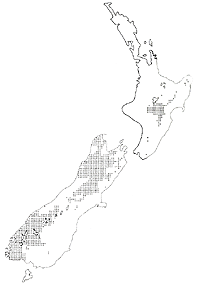Mountain Beech Nothofagus solandri var. cliffortioides

Product qualities
The colour of New Zealand mountain beech heartwood ranges from honey coloured to light brown, sometimes with darker blackish streaks. The sapwood is light brown and there is not a strong differentiation between sap and heartwood. The grain is straight, with a fine and even texture and a rich lustre.
Uses and applications
Furniture, joinery, flooring and decking.
Physical and mechanical properties
Mountain Beech (Nothofagus solandri var. cliffortioides) generally shares the same wood and working properties as Black beech (Nothofagus solandri var solandri).
Mountain beech has excellent strength properties and hardness with exceptional dimensional stability once dry (12% m.c.). The wood is not slow drying like red or hard beech. However it is prone to internal checking and distortion.
Has good potential for impact handles.
The fine and even texture of mountain beech allows for uniform wearing.
Sawing, machining, finishing and turning properties are all excellent.
Minimal sanding is required after machining to achieve a smooth high quality finish.
Mountain beech glues, stains and paints well.
Its steam bending properties are excellent.
Moderately easy to split. Nailing is satisfactory but requires care.
Galvanised fixings are recommended for exterior uses because unprotected iron nails can stain the timber. Alternatives include stainless steel, silicon bronze or copper.
The product has no odour.
Availability
May be available in the marketplace
Natural durability
Mountain beech heartwood is likely to be durable and should be able to be used in exterior exposed situations. It should be suitable for outdoor decking and should achieve Hazard Class H3.2 durability. Pathological heartwood is non-durable. Mountain beech sapwood is suitable for internal end-uses and is resistant to anobium and lyctus borers..
Disclaimer: While every effort is made to ensure the accuracy of the information provided on this site, Farm Forestry Timbers Society do not accept liability for any consequences arising from reliance on the information published. If readers have any doubts about acting on any articles they should seek confirming, professional advice.
 Farm Forestry New Zealand
Farm Forestry New Zealand Farm Forestry Timbers - Headlines
Farm Forestry Timbers - Headlines